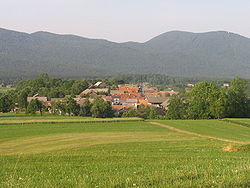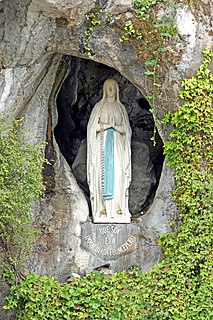| Sušje | |
|---|---|
 | |
| Coordinates: 45°45′31.63″N14°41′12.15″E / 45.7587861°N 14.6867083°E Coordinates: 45°45′31.63″N14°41′12.15″E / 45.7587861°N 14.6867083°E | |
| Country | |
| Traditional region | Lower Carniola |
| Statistical region | Southeast Slovenia |
| Municipality | Ribnica |
| Area | |
| • Total | 1.17 km2 (0.45 sq mi) |
| Elevation | 531.8 m (1,744.8 ft) |
| Population (2002) | |
| • Total | 136 |
| [1] | |
Sušje (pronounced [ˈsuːʃjɛ] ; German : Suschje [2] ) is a village in the Municipality of Ribnica in southern Slovenia. The area is part of the traditional region of Lower Carniola and is now included in the Southeast Slovenia Statistical Region. [3]

German is a West Germanic language that is mainly spoken in Central Europe. It is the most widely spoken and official or co-official language in Germany, Austria, Switzerland, South Tyrol (Italy), the German-speaking Community of Belgium, and Liechtenstein. It is also one of the three official languages of Luxembourg and a co-official language in the Opole Voivodeship in Poland. The languages which are most similar to German are the other members of the West Germanic language branch: Afrikaans, Dutch, English, the Frisian languages, Low German/Low Saxon, Luxembourgish, and Yiddish. There are also strong similarities in vocabulary with Danish, Norwegian and Swedish, although those belong to the North Germanic group. German is the second most widely spoken Germanic language, after English.

A village is a clustered human settlement or community, larger than a hamlet but smaller than a town, with a population ranging from a few hundred to a few thousand. Though villages are often located in rural areas, the term urban village is also applied to certain urban neighborhoods. Villages are normally permanent, with fixed dwellings; however, transient villages can occur. Further, the dwellings of a village are fairly close to one another, not scattered broadly over the landscape, as a dispersed settlement.

The Municipality of Ribnica is a municipality in southern Slovenia. The seat of the municipality is the town of Ribnica. It is part of the traditional region of Lower Carniola and is now included in the Southeast Slovenia Statistical Region. Archaeological evidence shows that the area has been settled at least since the late Bronze Age between 1300 and 900 BC.
There is a small roadside chapel-shrine in the settlement, dedicated to the Our Lady of Lourdes. It was built in the late 19th century in the Neo-Gothic style. [4]

A wayside shrine is a religious image, usually in some sort of small shelter, placed by a road or pathway, sometimes in a settlement or at a crossroads, but often in the middle of an empty stretch of country road, or at the top of a hill or mountain. They have been a feature of many cultures, including Catholic and Orthodox Europe and Shinto Japan.

Our Lady of Lourdes is a Roman Catholic title of the Blessed Virgin Mary venerated in honour of the Marian apparitions that reportedly occurred in 1858 in the vicinity of Lourdes in France. The first of these is the apparition of 11 February 1858, when 14-year old Bernadette Soubirous told her mother that a "lady" spoke to her in the cave of Massabielle while she was gathering firewood with her sister and a friend. Similar apparitions of the "Lady" were reported on seventeen occasions that year, until the climax revelation of Our Lady of the Immaculate Conception took place.

Gothic Revival is an architectural movement popular in the Western World that began in the late 1740s in England. Its popularity grew rapidly in the early 19th century, when increasingly serious and learned admirers of neo-Gothic styles sought to revive medieval Gothic architecture, in contrast to the neoclassical styles prevalent at the time. Gothic Revival draws features from the original Gothic style, including decorative patterns, finials, lancet windows, hood moulds and label stops.








